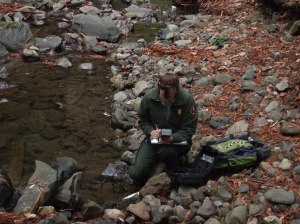
NPS staff measure water quality parameters throughout Bay Area parks. Credit: NPS Photo.
Point Reyes National Seashore staff undertake many research projects each year, such as studying tule elk and monitoring harbor seals and other pinnipeds that haul out on the beaches. However, Seashore researchers do not operate in a vacuum. Both the Pacific Coast Science and Learning Center (PCSLC) and the San Francisco Bay Area Inventory and Monitoring Network (I&M) conduct or coordinate research throughout many of the parks in the region, including Point Reyes National Seashore, Golden Gate National Recreation Area, Pinnacles National Monument, and Muir Woods National Monument.
Some current PCSLC and research partner studies include Seafloor Habitat Mapping, Coastal Biophysical Inventory, and Fungal Biodiversity Inventories. The National Park Service also conducts long-term monitoring of critical natural resources. Much like a doctor measures blood pressure and body temperature to assess health, the I&M program tracks a suite of high priority ecological indicators as a way to measure the health of the parks.
These ecological indictors fall into four major categories:
Air and Climate
Scientists evaluate weather, climate, and air quality parameters to support understanding of local climate change and to alert staff and visitors about potential exposure to air pollution. Parameters include temperature, precipitation, ozone concentration, and visibility.
Water
Researchers measure water quality and quantity parameters to identify pollution sources, to ensure NPS meets minimum water quality standards, and to make certain that enough water is flowing through the stream to support the requirements of threatened and endangered species. Parameters include pH, dissolved oxygen, water temperature, indicator bacteria, and flow.
Ecosystem Patterns and Processes
Researchers assess landscape vegetation and land use to evaluate changes and demonstrate the importance of park land in a rapidly urbanizing landscape.
Biological Integrity
Flora: Researchers identify the need for wetland and riparian habitat restoration by measuring extent, type, and species composition. Researchers also study species diversity in plant communities and detect invasive plants to develop priorities for habitat management and restoration as well as eradication of invasive species.
Fauna: Researchers monitor a variety of animal species, including those threatened and endangered, to identify habitat protection and restoration needs and to recommend management efforts. The monitored species comprise coho salmon, amphibians and reptiles, landbirds, western snowy plover, northern spotted owl, raptors, and pinnipeds such as harbor seals.
For more information, visit http://science.nature.nps.gov/im/units/sfan/science_in_parks.cfm.



[…] Bloggers For Change placed an interesting blog post on Natural Resources and Science in Bay Area ParksHere’s a brief overviewThe National Park Service also conducts long-term monitoring of critical natural resources. … Scientists evaluate weather, climate, and air […]
By: Topics about Silence-day » Archive » Natural Resources and Science in Bay Area Parks on May 5, 2009
at 4:26 am
[…] on this…I am very thankful for the very delightful posts from earth911.com, pointreyesscience.wordpress.com, livinintheloin.com – all of them 3 helped me forming my […]
By: » Accessibility in the Golden Gate National Recreation Area gate national recreation area Blog on May 10, 2009
at 1:13 pm